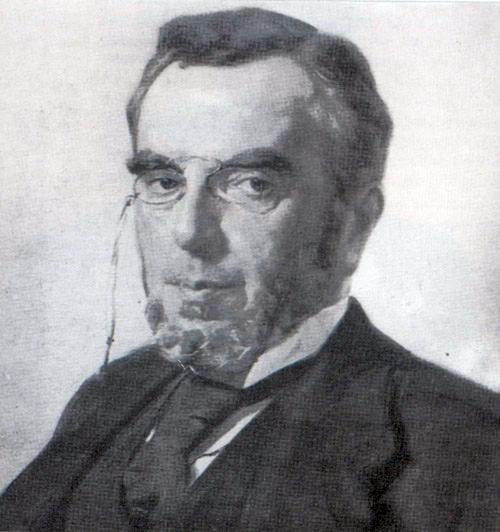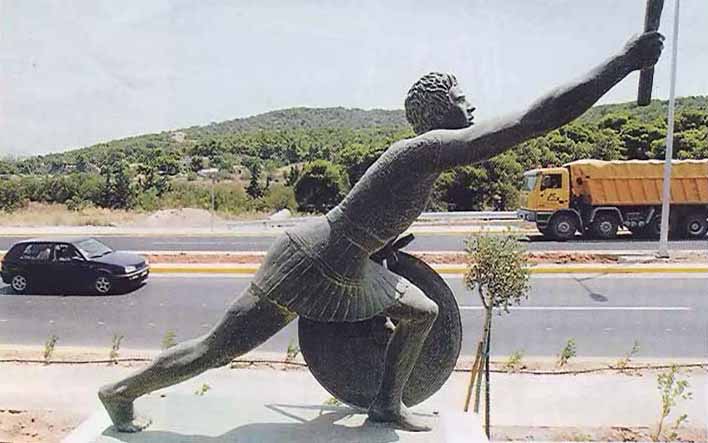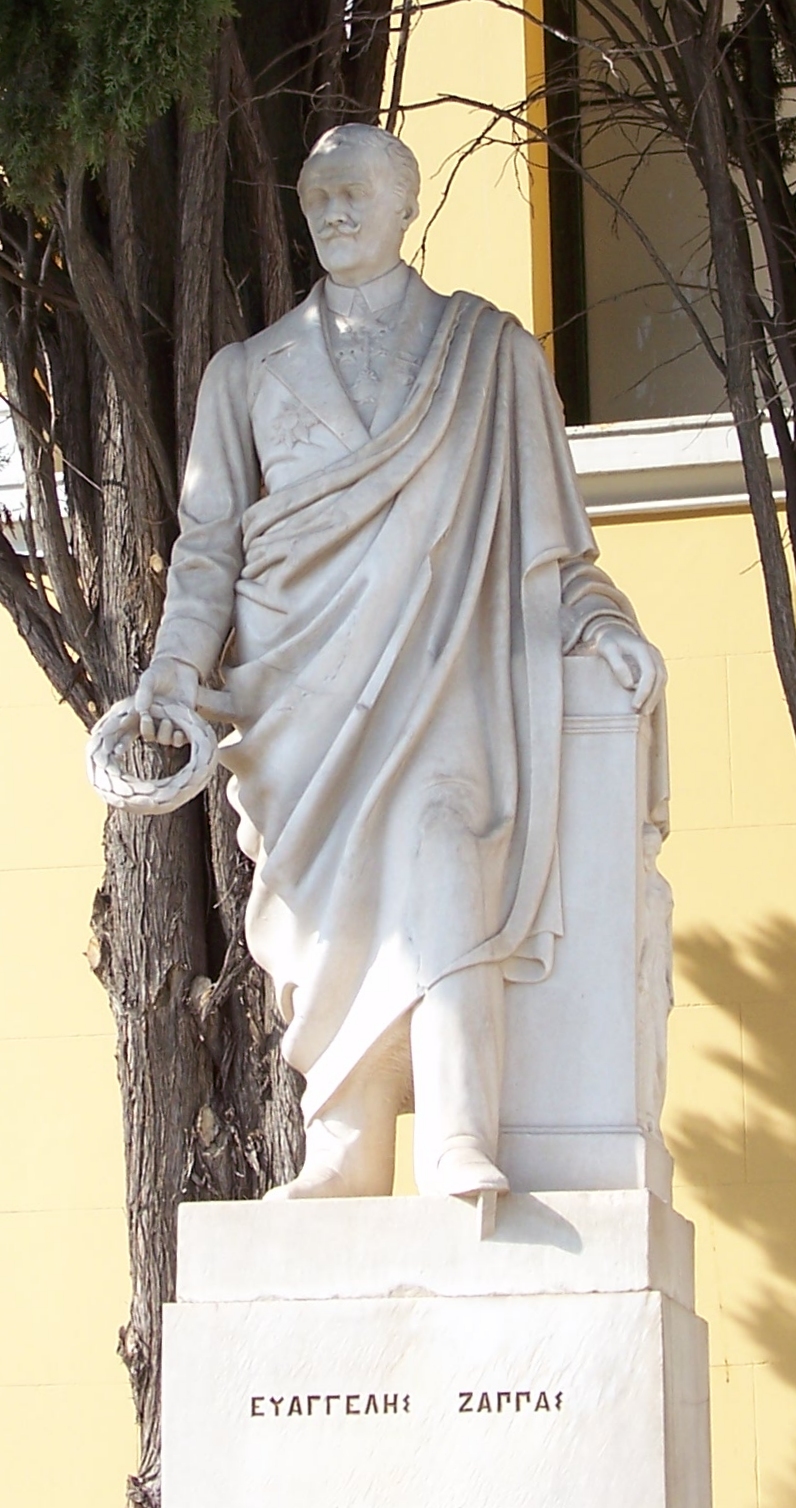|
Panathinaiko
The Panathenaic Stadium ( el, ќ†ќ±ќљќ±ќЄќЈќљќ±ѕКќЇѕМ ќ£ѕДќђќіќєќњ, Panathina√ѓk√≥ St√°dio, ), as spelled by Philostratus. or ''Kallimarmaro'' (ќЪќ±ќїќїќєќЉќђѕБќЉќ±ѕБќњ, , lit. "beautiful marble") is a multi-purpose stadium in Athens, Greece. One of the main historic attractions of Athens, it is the only stadium in the world built entirely of marble. A stadium was built on the site of a simple racecourse by the Athenian statesman Lykourgos (Lycurgus) BC, primarily for the Panathenaic Games. It was rebuilt in marble by Herodes Atticus, an Athenian Roman senator, by 144 AD it had a capacity of 50,000 seats. After the rise of Christianity in the 4th century it was largely abandoned. The stadium was excavated in 1869 and hosted the Zappas Olympics in 1870 and 1875. After being refurbished, it hosted the opening and closing ceremonies of the first modern Olympics in 1896 and was the venue for 4 of the 9 contested sports. It was used for various purposes in the 20th century and was ... [...More Info...] [...Related Items...] OR: [Wikipedia] [Google] [Baidu] |
Athens
Athens ( ; el, ќСќЄќЃќљќ±, Ath√≠na ; grc, бЉИќЄбњЖќљќ±ќє, Ath√™nai (pl.) ) is both the capital and largest city of Greece. With a population close to four million, it is also the seventh largest city in the European Union. Athens dominates and is the capital of the Attica region and is one of the world's oldest cities, with its recorded history spanning over 3,400 years and its earliest human presence beginning somewhere between the 11th and 7th millennia BC. Classical Athens was a powerful city-state. It was a centre for the arts, learning and philosophy, and the home of Plato's Academy and Aristotle's Lyceum. It is widely referred to as the cradle of Western civilization and the birthplace of democracy, largely because of its cultural and political influence on the European continentвАФparticularly Ancient Rome. In modern times, Athens is a large cosmopolitan metropolis and central to economic, financial, industrial, maritime, political and cultural life in Gre ... [...More Info...] [...Related Items...] OR: [Wikipedia] [Google] [Baidu] |
1896 Summer Olympics
The 1896 Summer Olympics ( el, ќШќµѕБќєќљќњќѓ ќЯќїѕЕќЉѕАќєќ±ќЇќњќѓ ќСќ≥ѕОќљќµѕВ 1896, Therino√≠ Olympiako√≠ Ag√≥nes 1896), officially known as the Games of the I Olympiad ( el, ќСќ≥ѕОќљќµѕВ ѕДќЈѕВ 1ќЈѕВ ќЯќїѕЕќЉѕАќєќђќіќ±ѕВ, Ag√≥nes tis 1is Olympi√°das) and commonly known as Athens 1896 ( el, ќСќЄќЃќљќ± 1896), was the first international Olympic Games held in modern history. Organised by the International Olympic Committee (IOC), which had been created by French aristocrat Pierre de Coubertin, it was held in Athens, Greece, from 6 to 15 April 1896. Fourteen nations (according to the IOC, though the number is subject to interpretation) and 241 athletes (all males; this number is also disputed) took part in the games. Participants were all European, or living in Europe, with the exception of the United States at the 1896 Summer Olympics, United States team. Over 65% of the competing athletes were Greek. Winners were given a silver medal, while runners-up received a copper medal. ... [...More Info...] [...Related Items...] OR: [Wikipedia] [Google] [Baidu] |
2004 Summer Olympics
The 2004 Summer Olympics ( el, ќШќµѕБќєќљќњќѓ ќЯќїѕЕќЉѕАќєќ±ќЇќњќѓ ќСќ≥ѕОќљќµѕВ 2004, ), officially the Games of the XXVIII Olympiad ( el, ќСќ≥ѕОќљќµѕВ ѕДќЈѕВ 28ќЈѕВ ќЯќїѕЕќЉѕАќєќђќіќ±ѕВ, ) and also known as Athens 2004 ( el, ќСќЄќЃќљќ± 2004), were an international multi-sport event held from 13 to 29 August 2004 in Athens, Greece. The Games saw 10,625 athletes compete, some 600 more than expected, accompanied by 5,501 team officials from 201 countries, with 301 medal events in 28 different Olympic sports, sports. The 2004 Games marked the first time since the 1996 Summer Olympics that all countries with a National Olympic Committee were in attendance, and also marked the first time Athens hosted the Games since their first modern incarnation in 1896 Summer Olympics, 1896 as well as the return of the Olympic games to its birthplace. Athens became one of only four cities at the time to have hosted the Summer Olympic Games on two occasions (together with Paris, London and Los ... [...More Info...] [...Related Items...] OR: [Wikipedia] [Google] [Baidu] |
Athens Classic Marathon
The Athens Classic Marathon The Authentic is an annual marathon road race held in Athens, Greece, normally in early November (the second Sunday of November), since 1972. It also often serves as Greece's national marathon championships. The race attracted 43,000 competitors in 2015 of which 16,000 were for the 42.195 kilometre (26.2 mile) course, both numbers being an all-time record for the event. The rest of the runners competed in the concurrent 5 and 10 kilometres road races and the racewalking contest. The marathon race and course is inspired by the Ancient Greek legend of Pheidippides, a messenger who is said to have run from Marathon to Athens to bring news of the Greek victory over the Persians at the Battle of Marathon. Taking from the tradition of the Olympic Torch, the race features the Marathon Flame, which is lit at the Tomb of the Battle of Marathon and carried to the stadium in Marathon before the beginning of each race.Butcher, Pat (2008-11-06)Marathon ... [...More Info...] [...Related Items...] OR: [Wikipedia] [Google] [Baidu] |
Zappas Olympics
The Zappas Olympics ( el, ќЦќђѕАѕАќµќєќµѕВ ќЯќїѕЕќЉѕАќєќђќіќµѕВ), simply called Olympics ( el, ќЯќїѕНќЉѕАќєќ±, ''Olympia'') at the time, were a series of athletic events held in Athens, Greece, in 1859, 1870, and 1875 sponsored by Greek businessman Evangelis Zappas. These games were one of the first revivals of the ancient Olympic Games in the modern era. Their success provided further inspiration for William Penny Brookes in England, whose games had been running since 1850, and the International Olympic Committee series from 1896. Zappas' contribution in this process was vital: not only were the games hosted at his own initiative, he also provided the funds for the staging of the games, as well as for the construction of much-needed infrastructure, including the refurbishment of the ancient Panathenaic Stadium, which hosted the Games of 1870 and 1875. The same stadium would also host the first IOC Games of 1896,Findling, Pelle (2004), p. 13 the 1906 Intercalated Games, and arc ... [...More Info...] [...Related Items...] OR: [Wikipedia] [Google] [Baidu] |
Ilissos
The Ilisos or Ilisus ( el, ќЩќїќєѕГѕМѕВ, ) is a river in Athens, Greece. Originally a tributary of the Kifisos, it has been rechanneled to the sea. It is now largely channeled underground, though as of June 2019 there are plans to unearth the river. Together with the neighbouring river Kifisos, it drains a catchment area of . Etymology Its name is in all probability Pre-Greek: it features the ending ''-s√≥s''/''-ss√≥s''/''-tt√≥s'', which it shares with many other toponyms in Attica and other rivers in Greece, all of which are considered linguistic substratum survivals. Ancient Athens During antiquity, the river flowed outside the city walls of Athens: Plato wrote in Critias that the river was one of the borders of the ancient walls. Its banksвАФin the busy intersection that presently features the Hilton Hotel and the National GalleryвАФwere grassy and shaded by plane trees, and were considered idyllic in antiquity; they were the favored haunts of Socrates for his walks and te ... [...More Info...] [...Related Items...] OR: [Wikipedia] [Google] [Baidu] |
Pangrati
Pangrati or Pagrati ( el, ќ†ќ±ќ≥ќЇѕБќђѕДќє) is a neighborhood in Central Athens, Greece, having an estimated population of 35,173 residents. Named after the ancient sanctuary of Hercules Pancrates ("All Powerful"), its frontage runs from Vasilissis Sofias Avenue along to Vasileos Konstantinou Avenue and Vassileos Alexandrou Avenue, just a few minutes walk from the National Gardens. One of the most important landmarks of Pangrati is the Panathinaiko Stadium that hosted the first modern Olympic Games in 1896. The First Cemetery of Athens, the official cemetery for the City of Athens, lies within the neighborhood's limits. Pangrati includes the Ilissos river valley and extends to the south as far as the Panathinaic Stadium and the First Cemetery of Athens. Its eastern boundary was once defined by the Hymettus Mountain slopes but with the extension of the city in interwar period the modern eastern boundary is Nikiforidi Str. and Iliados Str., including Deliolani Square. To the ... [...More Info...] [...Related Items...] OR: [Wikipedia] [Google] [Baidu] |
USK Praha
USK Praha, ( cs, Univerzitn√≠ Sportovn√≠ Klub Praha, University Sports Club Prague), formerly known as Slavia V≈† Praha ( cs, Slavia Vysok√© ≈†koly Praha), is a Czech professional basketball club that was founded in 1953 in the city of Prague. USK Praha plays in the NBL, the highest competition in the Czech Republic. It is a 14-times national champion. USK Praha became the first and so far the only men's basketball club in Czech Republic, as well as former Czechoslovakia, to win one of the European cup competitions, the FIBA Cup Winners' Cup in 1969. History The club won the 2nd tier FIBA European Cup Winners' Cup in the 1968вАУ69 season, only a year after losing the same title in the final game of the 1967вАУ68 season against AEK. Slavia also reached the FIBA European Champions Cup Final during the 1965вАУ66 season, where they lost to Simmenthal Milano. Honours Total titles: 15 Domestic competitions * Czech League : Winners (3): 1993, 1999вАУ00, 2000вАУ01 : ''Runne ... [...More Info...] [...Related Items...] OR: [Wikipedia] [Google] [Baidu] |
National Garden, Athens
The National Garden (formerly the Royal Garden) ( el, ќХќЄќљќєќЇѕМѕВ ќЪќЃѕАќњѕВ)(it was named Royal Garden until 1974) is a public park of in the center of the Greek capital, Athens. It is located between the districts of Kolonaki and Pangrati, directly behind the Greek Parliament building (The Old Palace) and continues to the South to the area where the Zappeion is located, across from the Panathenaiko or Kalimarmaro Olympic Stadium of the 1896 Olympic Games. The Garden also encloses some ancient ruins, column drums and Corinthian capitals of columns, mosaics, and other features. On the Southeast side are the busts of Ioannis Kapodistrias, the first governor of Greece, and of the Philhellene Jean-Gabriel Eynard. On the South side are the busts of the celebrated Greek poets Dionysios Solomos, author of the Greek National Hymn, and Aristotelis Valaoritis. History The Royal Garden was commissioned by Queen Amalia in 1838 and completed by 1840. It was designed by the German ag ... [...More Info...] [...Related Items...] OR: [Wikipedia] [Google] [Baidu] |
Panathenaic Games
The Panathenaic Games ( grc, ќ†ќ±ќљќ±ќЄќЃќљќ±ќєќ±) were held every four years in Athens in Ancient Greece from 566 BC to the 3rd century AD. These Games incorporated religious festival, ceremony (including prize-giving), athletic competitions, and cultural events hosted within a stadium. History The Panathenaic festival was formed in order to honor the goddess Athena who had become the patron of Athens after having a competition with the god Poseidon where they were to win the favor of the Athenian people by offering the people gifts. The festival would also bring unity among the people of Athens. The attempted assassination of the tyrants Hippias and Hipparchus during the Panathenaea in 514 BC by Harmodius and Aristogeiton was often regarded as the birth of Athenian democracy. Events The competitions for which the festival came to be known were part of the Great Panathenaia, a much larger religious occasion. These ritual observances consisted of numerous sacrifices to Ath ... [...More Info...] [...Related Items...] OR: [Wikipedia] [Google] [Baidu] |
AEK Athens B
A.E.K ( el, AEK , formally ќСќЄќїќЈѕДќєќЇќЃ ќИќљѕЙѕГќєѕВ ќЪѕЙќљѕГѕДќ±ќљѕДќєќљќњѕЕѕАѕМќїќµѕЙѕВ; Athlitik√≠ √Йnosis KonstantinoupѕМleos, ''Athletic Union of Constantinople''), known as A.E.K, is a major Greek multi-sport club based in Nea Filadelfeia, Athens. The club is more commonly known in European competitions as A.E.K Athens. Established in Athens in 1924 by Greek refugees from Constantinople after the 1919вАУ22 Greco-Turkish war and the subsequent population exchange between Greece and Turkey, it is one of the three most successful clubs in Greece. While it fields teams in many sports under the umbrella of its amateur sports arm, Amateur AEK ( el, ќХѕБќ±ѕГќєѕДќµѕЗќљќєќЇќЃ ќСќХќЪ; Erasitechnikќѓ AEK) with A.E.K. Handball team to be the best Greek handball club in European achievements having obtained one EHF European Cup (in 2021) and having also reached to the finals (in 2018) and to the semi-finals (in 2019), AEK sports club is best known for its professional football team ... [...More Info...] [...Related Items...] OR: [Wikipedia] [Google] [Baidu] |
Anastasios Metaxas
Anastasios Metaxas ( el, ќСќљќ±ѕГѕДќђѕГќєќњѕВ ќЬќµѕДќ±ќЊќђѕВ; 27 February 1862 вАУ 28 January 1937) was a Greek architect and shooter. Biography Metaxas was the royal architect of George I of Greece and is best known for being the architect chosen by George Averoff to restore also the Panathinaiko Stadium for the 1896 Summer Olympics in Athens, the birth of the modern Olympic movement, while the design was from Ernst Ziller. He studied architecture at University of Dresden and passed with honours, in his time he would also expand or reform many historic buildings including the Benaki Museum and the National Archaeological Museum, Athens to name a couple. Other works of his include the design for St Andrew's Cathedral, Patras and various public buildings and mansions in Athens. Metaxas was also an avid shooter and would appear in four Summer Olympics and win two medals, he firstly competed in the 1896 Summer Olympics in the stadium he helped restore, he entered the 200 metre mi ... [...More Info...] [...Related Items...] OR: [Wikipedia] [Google] [Baidu] |








